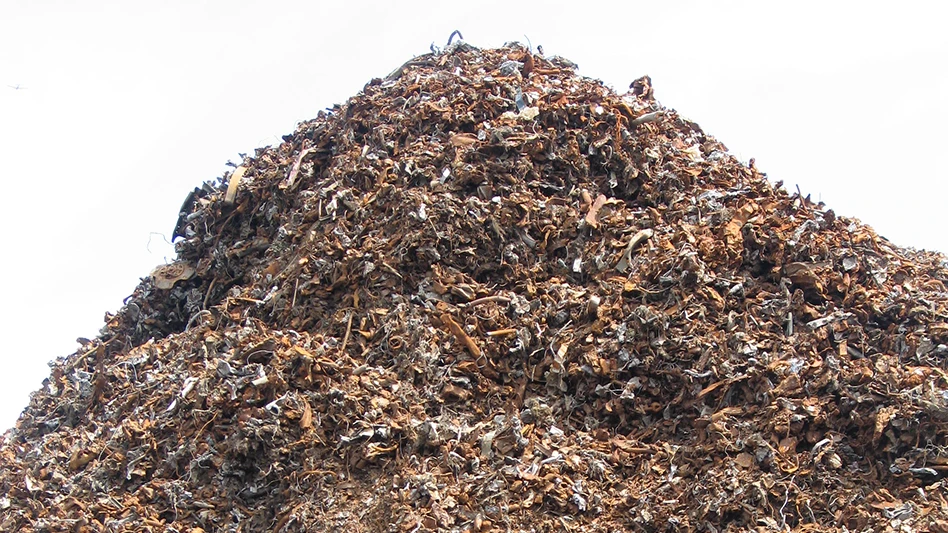
Recycling Today archives
Although its pricing in the United States and beyond has been at the lower end of its range—suggesting plenty of supply—ferrous scrap nonetheless is likely to appear on more national “strategic raw material” lists, according to Netherlands-based ING Bank N.V.
A recent report from the ING commodities division concludes that with decarbonization efforts around the world ramping up, ferrous scrap rapidly is becoming a highly sought-after commodity, especially as countries begin to implement new export restrictions to meet their key net-zero goals.
The analysis by London-based ING Commodities Strategist Ewa Manthey reviews the current cross-border ferrous scrap trading landscape familiar to those who trade the secondary commodity globally, citing statistics gathered by the Brussels-based Bureau of International Recycling (BIR).
"The European Union is the largest exporter of scrap in the world [and] the main buyer was Turkey,” which purchased more than 10.5 million metric tons of imported ferrous scrap in 2022, Manthey says.
A global map of 2022 scrap-fed electric arc furnace (EAF) steelmaking market share shows Turkey with a 71.5 percent EAF share, well ahead of the EU’s current 43.7 percent market share and a 19.1 percent EAF share in the United Kingdom.
In Europe and the U.K., a sizable amount of new EAF capacity is under construction or on the drawing board.
Whether it is good strategy or instead a protectionism request by local steel producers, ING sees ferrous scrap export restrictions as growing and poised to grow yet more.
"Exports of ferrous scrap are most actively restricted in Africa, MENA [Middle East and North Africa] countries and Asia, according to data from the Organization for Economic Co-operation and Development [OECD],” Manthey says.
She adds most of these countries tend to be scrap-deficit nations, with historically low steel consumption and insufficient scrap resources, and singles out export duties as the most common restriction but also notes that outright bans “are used almost as often as duties.”
The EU, like the U.S., for decades has been a scrap-surplus location. Nonetheless, the European Parliament approved a proposal to revise the Waste Shipment Regulation (WSR) earlier this year.
Additionally, another EU effort to add ferrous scrap to its Critical Raw Materials Act (CRMA) could result in ferrous scrap being categorized as a protected material, creating another export barrier. “If ferrous scrap is added to the final list of the CRMA, it could become challenging to continue exporting the material, including to buyers inside the OECD like Turkey,” Manthey says.
Should those revisions come into effect, starting in 2025, the export of nonhazardous scrap for recycling, particularly ferrous and nonferrous scrap, to countries outside the OECD will be allowed only if those countries apply for consent and demonstrate their ability to manage it effectively.
The combination of increased EAF capacity and outbound restrictions means the EU can turn from a net scrap exporter to a net scrap importer in just five years, Manthey says, citing data from the International Rebar Producers and Exporters Association (IREPAS).
Such restrictions in Europe are likely to have significant consequences for the global scrap market, she adds, given that about 25 percent of the EU’s ferrous scrap exports go to non-OECD countries.
India is another nation where steelmakers could be unpleasantly surprised by the prospect of a scrap-deficit EU. Manthey notes the country plans annually to import about 30 million tons of raw steel materials (scrap, pig iron and scrap alternatives) by 2030 to meet the government’s vision of achieving 300 million metric tons per year of steel capacity.
Manthey looks to Europe and the U.S. when portraying a trend of steel producers buying up scrap processing capacity, pointing to ongoing acquisitions by Nucor Corp. in the U.S. and ArcelorMittal in Europe. ING anticipates further such acquisition activity in the remainder of this decade.
“Demand for ferrous scrap will continue to grow globally amid the increasing focus on the material as a key raw material in the low-carbon emissions steelmaking process," she says.
“We expect vertical integration in the steel industry to continue as steel mills seek to secure access to scrap steel required for low-carbon emission steelmaking, which in turn will drive mergers and acquisitions moving forward.”
The full ING analysis can be found here.
Latest from Recycling Today
- BMW Group, Encory launch 'direct recycling’ of batteries
- Loom Carbon, RTI International partner to scale textile recycling technology
- Goodwill Industries of West Michigan, American Glass Mosaics partner to divert glass from landfill
- CARI forms federal advocacy partnership
- Monthly packaging papers shipments down in November
- STEEL Act aims to enhance trade enforcement to prevent dumping of steel in the US
- San Francisco schools introduce compostable lunch trays
- Aduro graduates from Shell GameChanger program





